- Brazil-Pioneer
- Brazil-Pioneer
- Brazil-pioneer
- Brazil-pioneer
- Brazil-Pioneer
- Brazil-Pioneer
- brazil-pioneer
- Brazil-Pioneer
- Brazil-pioneer
- Brazil-pioneer
| Temple Square is always beautiful in the springtime. Gardeners work to prepare the ground for General Conference. © 2012 Intellectual Reserve, Inc. All rights reserved. | 1 / 2 |
This story appears here courtesy of TheChurchNews.com. It is not for use by other media.
By Valerie Walton, Church News
Editor’s note: This month marks the 175th anniversary of the vanguard company of pioneers arriving in the Salt Lake Valley, in July 1847, after Latter-day Saints were driven by mobs out of the Nauvoo, Illinois, area the preceding year. The Church News this month honors achievements of pioneers crossing the Plains 175 years ago and also of Latter-day Saint pioneers of different times on every continent.
One fast Sunday last year in the Watford City Ward in North Dakota, a woman of African descent in her late 80s made her way to the podium, helped along by her daughter. In Portuguese and English, and with her daughter acting as translator, she began bearing her testimony.
Shari Buck recalled feeling the power of the Spirit fill the chapel. “I caught a few words she talked about. She mentioned Elder [James E.] Faust and President [Spencer W.] Kimball.” Listening to her testimony was a “soul-touching experience,” she said.
The experience had her wondering, “Who is this woman?”
A new calling as a member of the Glendive Montana Stake Relief Society presidency meant Buck often traveled to other wards on Sundays and could likely have missed this testimony. By asking around the ward, spotting the woman’s photo in a repromoted Church News article, and then becoming one of her official ministering sisters, Buck soon came to learn that this woman who bore a powerful testimony in Portuguese and English is a significant Brazilian pioneer in the Church — a woman whose influence has been felt across the world.
Sister Rudá Tourinho de Assis Martins, wife of the late Elder Helvécio Martins — the first Black general authority in the Church — had just moved to the prairies and oil fields of North Dakota to live with her daughter Marisa Helena Knudson. With her, the 90-year-old brought a lifetime of faithful service and an unshakeable testimony of the restored gospel of Jesus Christ.
Before Finding the Church
Rudá Tourinho de Assis was born January 1, 1932, to Francisco Neves de Assis and Margarida Tourinho de Assis in Rio de Janeiro, Brazil.
“I remember the house where we lived in, house No. 7,” she said. She shared memories of playing with her neighbor Cora, her mother giving the neighbor’s children bread and food to eat, the zinc fence with holes at the end of their backyard. “I was very curious, and I liked to look in the little hole to see what was on the other side. I knew there were chickens, dogs, cats.”
In 1953, she answered a job posting from the labor department and interviewed at the office where Helvécio Martins worked.
In his self-titled autobiography published in 1994, Elder Martins wrote, “When I came to work the following day, Rudá Tourinho [de] Assis was already there, the most beautiful woman I had ever seen. I loved her from the moment I first saw her and immediately lost interest in the girl I was dating at the time.”
The two got along well as co-workers, often having lunch or an afternoon snack together and getting to know each other. Despite Elder Martins’ immediate interest, it would take some time before Sister Martins was ready to date him.
“He would take me to the train station,” she said. “He was a person who had many girls interested in him; I couldn’t expect anything. I wasn’t even thinking about it. Can you imagine if I would get home and tell my mom and dad that I was dating?”
When the two did begin dating, it took some time before her father warmed up to Elder Martins, believing that he had no future. Although admitted to the most prestigious junior high school in the region, Belisário do Santos in Campo Grande, young Helvécio Martins had dropped out at age 11 to work full time to support his family.
Elder Martins’ autobiography described how Sister Martins encouraged him to return to junior high school and finish his education, writing, “Rudá stood by me for the next several years as I worked full time during the day and studied at night.”
“After [Helvécio] passed the exam to work for Petrobrás, then my father was OK because he was a person who took the exam and passed,” Sister Martins said. “He got a bachelor’s degree in accounting, so my father saw … he had a future [ahead of him].”
Helvécio Martins and Rudá Tourinho de Assis were married in the Santo Antônio dos Pobres church on Inválidos Street in the center of Rio de Janeiro on December 8, 1956. They are the parents of four children: Marcus Helvécio, Marisa Helena, Raphael and Aline.
For the next 15 years, his career as a corporate executive would bring the family much worldly success. Yet there was an emptiness begging to be filled.
Baptism
One April night in 1972, Elder Martins had just come home from a frustrating day at work and did not want to be bothered. Elder Thomas McIntire from California and Elder Steve Richards from Atlanta, Georgia — missionaries of The Church of Jesus Christ of Latter-day Saints — were in the area looking for people to teach.
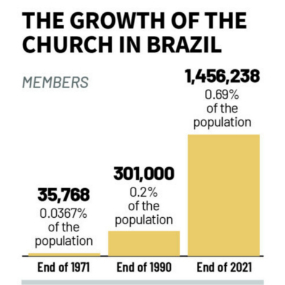
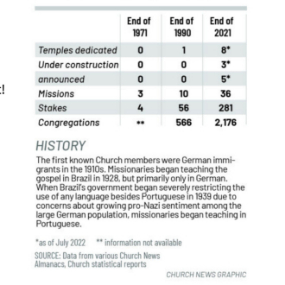
“Then they knocked on our door,” Sister Martins said.
She was about to turn them away when her husband heard that they were missionaries for The Church of Jesus Christ of Latter-day Saints. After having searched for spiritual fulfillment from a variety of Christian and other denominations, he wanted to learn more about this church.
Sister Martins recalled, “I couldn’t ask too many questions because they didn’t speak much Portuguese, and I didn’t speak English. Then I told my husband, ‘Go and practice your English because they only speak English.’ He said, ‘Great! It’s going to be really good.’ …
“My husband said, ‘Talk about the Church because I want to know more about it. We are indeed looking for something for us to join, but I need to know what the Church has to offer us.’”
So much of the population of Brazil has African heritage that it can be difficult to separate the two. And in 1972, the Church did not allow anyone of African descent to hold the priesthood or receive the ordinances in the temple. Additionally, racial discrimination was thought to be a North American issue and something that the Martins had not directly faced in Brazil.
From their very first meeting with the missionaries, the question of how the Church treated people of color was raised by Elder Martins, and they were told that Black men could not receive the priesthood. The missionaries explained that it was a policy established by the Church, and that Black members were not subservient to white members.
Sister Martins said that her husband told the missionaries that he didn’t want his son to be discriminated against, and he wanted him to feel comfortable. “He didn’t say it was him who was going to be discriminated against,” she said.
The very next Sunday, the family went to the local Church meetinghouse. “My husband wanted to know more, and to know more you have to go.”
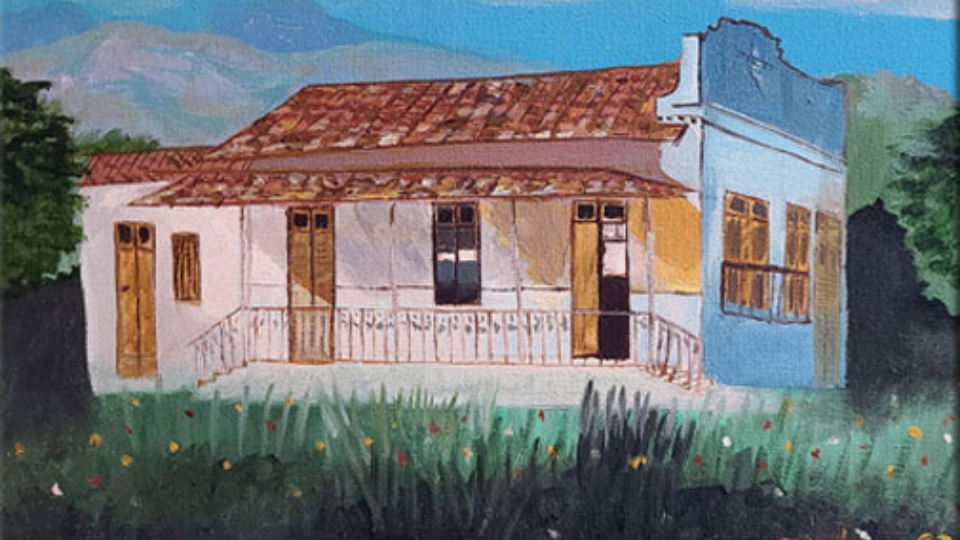
Brazil-Pioneer
This painting of the Rio Meier meetinghouse in Rio de Janeiro, Brazil, where the Martins family was baptized was created by Sister Rudá Tourinho de Assis Martins. Photo courtesy of Marcus Helvécio Martins, courtesy of Church News.All rights reserved.
The congregation met in a house on Joaquim Méier Street that was falling apart. “I wondered, ‘This is a church?’” she said. “I always passed by it and thought it was an old house ready to get demolished. We went inside, and there were some people who knew me [and they said], ‘Rudá, you’re here, how awesome!’”
Marcus was the first to decide he would be baptized. “I don’t know about you, but I have already decided, I’m going to this church,” she recalled him saying. “He was always the one who said, ‘I’m going to do this,’ and he really does. He was always like that.”
On July 2, 1972, Elder and Sister Martins, along with their oldest son, Marcus, were baptized as members of The Church of Jesus Christ of Latter-day Saints — 50 years ago. Their daughter, Marisa, who was only 6 at the time, would be baptized later.
Even today, Sister Martins remembers everything about that day. Only a few people came to their baptism since the Church in the area was small at that time. “When the sacrament meeting ended on that Sunday, the branch president announced, ’Now, we’re going to have a baptism today. Please, those who can, stay to support [them],” she said.
“I didn’t know my life would change so much,” Sister Martins said. “I have no doubt, having the Lord in charge, everything becomes better.”
Upon joining the Church, they didn’t become attached to the things of the world, Sister Martins said. “We wanted to go to Church on Sundays. We would get up, go to Church, come back and we always had our lunch. … At night there was always … the sacrament meeting. We would go to church to be able to be part of the sacrament meeting, and everything was great.”
Of their extended families, only Elder Martins’ sister Ivette Martins and his nephew Antônio “Tony” Martins Rodrigues, the son of another sister, joined the Church — the former in 1984 and the latter in the early 1990s. As the oldest brother, his decision to join the Church was respected. But Sister Martins’ parents distanced themselves from them.
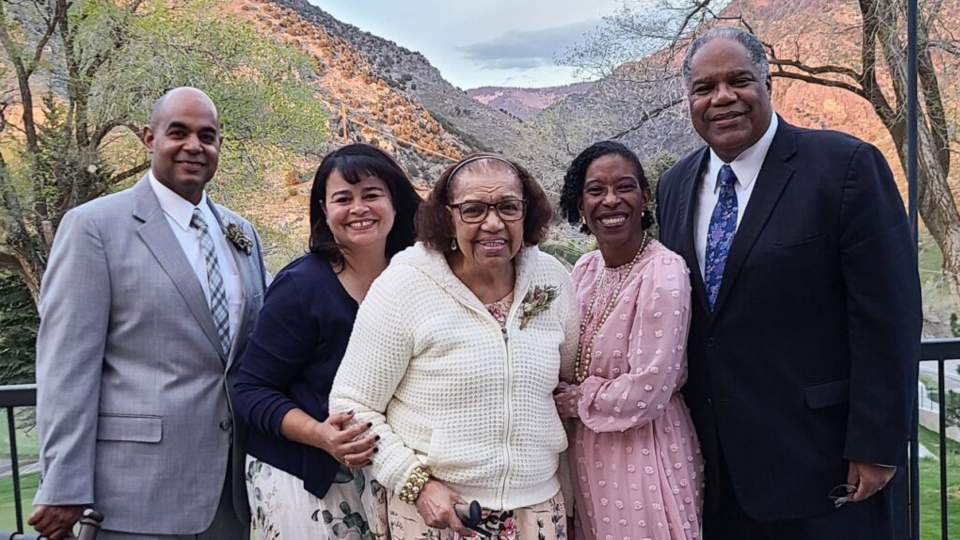
Brazil-Pioneer
Raphael Martins, Aline, Sister Rudá Tourinho de Assis Martins, Marisa Helena Knudson and Marcus Helvécio Martins pose for a photo at a family member’s wedding in Bountiful, Utah, in early 2022. Photo courtesy of the Martins family, courtesy of Church News. All rights reserved.
The Temple and the Priesthood
Ground was broken for the São Paulo Brazil Temple in March 1976. After serving as the Brazil North Region public relations director for the Church since 1974, Elder Martins was called to serve on the temple committee after the temple’s announcement in 1975.
The first time she and her husband visited the unfinished temple, Sister Martins recalled someone saying to them, “It’s a shame that you wouldn’t be able to enter the temple.”
“My husband said, ‘I don’t know. The One in Heaven is the one who’s going to decide who’s going to enter the temple and who will not,’” she said.
In 1977, the São Paulo Brazil Temple cornerstone ceremony was held with President Spencer W. Kimball presiding.
In his autobiography, Elder Martins recorded the counsel that President Kimball gave to him that day: “Brother Martins, what is necessary for you is fidelity. Remain faithful, and you will enjoy all the blessings of the gospel.”
That day came sooner than they had imagined.
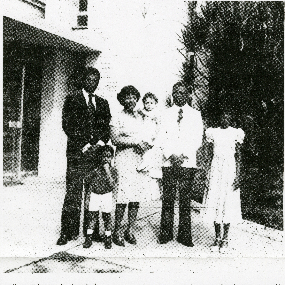
Brazil-Pioneer
Helvécio Martins and his wife, Rudá Martins, and their family. Photo courtesy of the Church History Library. 2022 by Intellectual Reserve, Inc. All rights reserved.On June 8, 1978, Sister Martins was visited by a friend who told her that the Church “announced that … all men in the Church, independent of their color, were going to receive the priesthood,” Sister Martins said. When her husband arrived home later that day, she relayed the news to him.
Elder Martins’ response, according to his wife: “‘Now we need to work, because they will need us to work.’”
Her son Marcus Martins was engaged at the time, having postponed his wedding from May to August. “He had everything arranged — house, furniture, everything, and it was close to where we lived,” Sister Martins said. “But he chose to go on a mission first.”
Soon after he and his father had the Aaronic and Melchezidek priesthoods conferred upon them, Marcus Martins would become one of the first three Black missionaries in the Church — the other two being Jacques Jonassaint from Haiti and Mary Sturlaugson from the United States. Marcus Martins entered the “new and still improvised MTC” located in a house owned by the Church on Itapeva Street in downtown São Paulo on August 8, 1978, he wrote in an email to the Church News.
A few months later, the São Paulo temple was dedicated on October 30, 1978. The Martins and their children “were sealed on the very first day the temple opened” for Brazilian Saints, Sister Martins said.
The November 11, 1978, issue of the Church News featured a photo of the Martins family leaving the chapel next to the temple on November 6, including Marcus Martins who was serving as a missionary in the Brazil São Paulo North Mission at the time.
“It is impossible for me to describe my feelings,” Elder Martins said after attending a dedicatory session, according to the article “Temple dedication brings blessings to many members.” “This is the realization of a great dream. It is a special spirit. The feeling is so much greater than it was before the temple was dedicated.”
Serving in the Church
Almost immediately upon baptism, the Lord put the Martinses to work. Elder Martins was called to serve as a Sunday School teacher and Sister Martins as a Primary presidency counselor. When their district became the first stake in Rio de Janeiro in 1972, Elder Martins was called to the stake Sunday School presidency and Sister Martins to the stake Primary presidency.
“The new stake was vast,” Elder Martins described in his autobiography. “Its far-flung boundaries posed an enormous geographical challenge to us as stake leaders trying to visit various wards and train leaders. … Because Primary in those days occurred on a week day, the stake Primary presidency traveled midweek. Often, we husbands would be waiting at the bus terminal after 11:00 at night or later, expecting our wives to return from their visits. Yet nobody complained of the distances we traveled — not even the Primary presidency, who often stayed out very late. We were happy to do the work.”
In 1987, Elder and Sister Martins were called to serve as president and companion in the Brazil Fortaleza Mission.
Elder Martins wrote that one of the most fulfilling parts of serving as a mission president was working side by side with his wife. “Rudá and I traveled together for hours by bus, car and plane, going back and forth over the backlands (sertão) of Brazil’s northeastern region to meet with the missionaries. We became much closer during those three years and learned many important things together: to communicate better with the Lord, to eliminate worldly things from our lives in order to become more spiritual, and to learn from people of all social, economic, and intellectual levels of society.”
They enjoyed becoming “parents” to 434 young men and women from Brazil, the United States and other nations.
During their mission service in early 1990, Elder Martins received a phone call, telling him and his wife to come to Salt Lake City to speak to President Thomas S. Monson, then Second Counselor to President Ezra Taft Benson in the First Presidency.
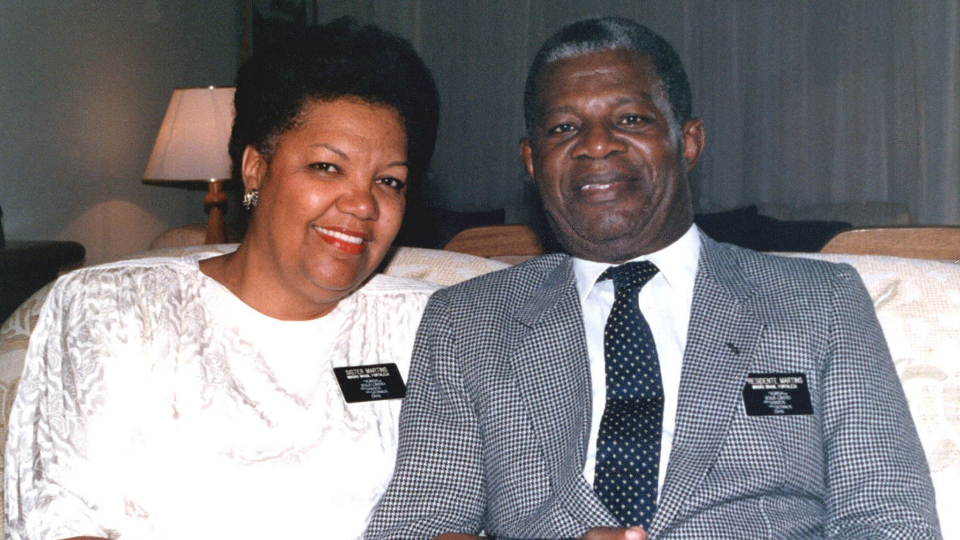
Brazil-Pioneer
President Helvécio Martins and Sister Rudá Martins of the Brazil Fortaleza Mission in 1988. He presided over that mission from 1987 until his call in 1990 as a member of the Church’s Second Quorum of the Seventy. Photo courtesy of the Martins family.All rights reserved.
At the airport, a Church employee met the Martins, who hadn’t brought any clothes for the cold winter weather. He drove them directly to President Monson’s office.
“I asked myself, ‘President Monson’s office?’” Sister Martins said. “I looked at my husband and told him, ‘What have you done wrong?
“He said, ‘Well, that I know, I didn’t do anything. What about you?’
“I told him, ‘That I know, I didn’t do anything. My work is on family history, to send names [to the temple] to be baptized, and that’s all. Nothing else.’
“And he told me, ‘OK, let’s go to see what happens.’”
President Monson was smiling and kind and asked them about their trip. Soon, he addressed Elder Martins and told him he was being called as a member of the Second Quorum of the Seventy. Unable to speak English, Sister Martins waited for her husband to explain what was going on in Portuguese.
“I heard and told him, ‘I think we just got to the right place. You’re going [places], and I’ll go with you. You’ll have to carry me. You’ll hold my hand and take me, because I don’t speak English. I know nothing about the language,’” she said.
Elder Martins replied, “Don’t worry, the Lord will open your mind.”
During the April 1990 general conference, Elder Martins was sustained as a General Authority Seventy, making him the first Black general authority in the Church. As a member of the second quorum he served for five years, from April 1990 to October 1995, and was a member of the Brazil Area presidency.
Following his release, the Martinses returned to Brazil. Elder Martins attended law school and graduated at the age of 74 in January 2005. He even gave the commencement address on how the law must protect the interests of the traditional family. A few months later, on May 14, 2005, he died of heart problems in São Paulo.
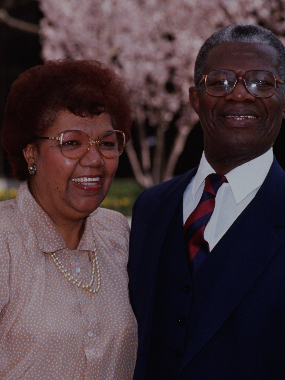
brazil-pioneer
Elder Helvécio Martins and his wife, Rudá Martins, in 1990 when he was called to Second Quorum of the Seventy. Photo courtesy of Church News archives. Copyright 2022 Deseret News Publishing Company.Testimony
Buck, now one of Sister Martins’ many unofficial ministering sisters in the Watford City Ward, can testify to the power of the testimony she first heard that fast Sunday back in 2021, and continues to hear and feel as their friendship has developed.
“We have people within our wards or branches that have amazing stories and testimonies and witnesses of Christ that maybe we never even get to hear about,” Buck said. “I was so glad I was there that day and heard her. It just resonated with me and I had to know more. I had to know who she was and how she came to North Dakota and just the strength that she has. Every time I’m with her, I feel that strong love and power from her.”
Sister Martins said, “My testimony is the most valuable thing I have.”
In her life, she has learned that one needs to have faith. “The first thing a person has to have is faith in the Lord, and pray to the Lord with fervor,” she said. “Because it’s not enough to say, ‘Oh Lord, I would like this and that.’ You need to tell the Lord what you’re going through, and [listen to] what He tells you to do.”
To this day, Sister Martins maintains a close relationship with the Lord. “I talk to Him. And He answers me through my dreams,” she said. I close my eyes and say, ‘Lord, I don’t know what I need to do. I have this and that. What should I do? What should I say to my daughter? To my son?’ I ask the Lord, and the Lord answers me because I have faith in Him. I know the Lord will not let me fall in a hole and stay there. He will do a lot for me. He always does.”
Copyright 2022 Deseret News Publishing Company.
